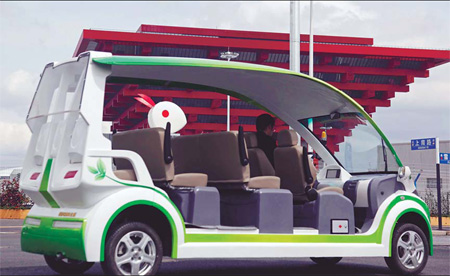China fuels ahead
Shanghai Volkswagen Automotive Co Ltd and Chinese manufacturers Chery and Chang'an are among those involved in China's latest fuel-cell project, which has been overseen by the Ministry of Science and Technology since 2001.
The ongoing Expo experiment, which sees visitors charged 10 yuan for a short ride in a fuel-cell buggy from the China Pavilion to the USA Pavilion, is the most advanced project of its kind in China, they said. Other companies are developing prototypes but they are not getting the same level of feedback, experience or government support.
"There are still problems of cost and the reliability of components, but we've already learnt a lot in just one month, such as about the quality of the battery and the controller over long-term repeat use," said Zhang.
Each of the Expo buggies cost 1.5 million yuan ($220,000) to build, or the same as a Ferrari 458 Italia sports car, he said. If the cost of the technology were factored in, the price tag would be higher.
Despite this, Zhang said the fuel-cell buggies have the potential to be both economical and environmentally friendly. They currently run at about one-third the cost of petrol by squeezing 400 kilometer out of their two tanks.
Professor Ma Jianxing, one of the men who built the portable hydrogen refueling station in Jiading, said Shanghai has a huge advantage in terms of obtaining hydrogen because of its sizable steel and coke industry.
Another problem is convincing people it is safe to compress dangerous chemical elements under high pressure in a way that leaves no margin for hydrogen leaks or explosions during a collision. Critics point to previous air disasters involving hydrogen leaks, such as the midair fire that engulfed the Hindenburg Zeppelin over New Jersey in 1937.
"According to our experience that has never happened," said Dr Ning Guobao, another member of the Tongji team, referring to the hydrogen tanks exploding during controlled crashes. "Remember there is also a risk of electric cars electrocuting people but that doesn't happen either."
The team is so confident it is now looking at ways of doubling the tank's pressure level from 350 bars to 700 bars so drivers can travel twice as far on a single tank.
But the threat of something going horribly wrong is always lurking over the horizon. Voicing concern about the possible side effects of radio waves, Ma urged reporters to switch off their cell phones last week as they thronged around the portable refueling station, which itself looks like a cross between a SCUD missile launcher and a giant scuba tank.
Some of the statistics used to promote fuel-cell vehicles can be misleading and need to be put in perspective. Many vehicles have a basic fuel stack but also rely on auxiliary power systems to compensate for their shortfalls, such as by installing small battery packs to make up for slow reaction times during operations such as gunning the ignition.
 |
| There are 196 fuel-cell vehicles being used at the Expo, including this one in front of the China Pavilion. |
 |
| Some of the sight-seeing fuel-cell buggies in the Expo Garden. |

 0
0 






